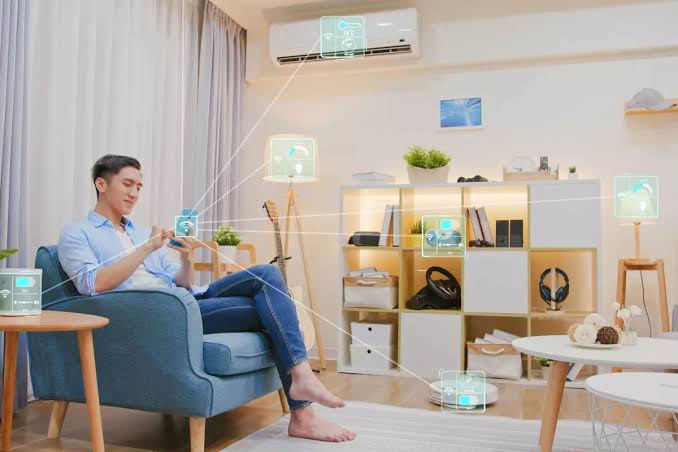
AI-Powered Home Assistants: Are They Really Getting Smarter?
AI-powered home assistants are evolving rapidly, becoming more intelligent, responsive, and personalized. Using advanced AI like natural language processing, they perform everyday tasks, support smart homes, and assist people with accessibility needs. Though concerns about data privacy exist, companies are improving security features. With each update, these assistants are not just smarter but also more adaptable to users’ lifestyles, marking a promising future for AI in daily living.
✨ Raghav Jain

Introduction
From turning on the lights with a voice command to managing grocery lists, AI-powered home assistants have quickly moved from novelty gadgets to essential parts of modern homes. Devices like Amazon’s Alexa, Google Assistant, and Apple’s Siri now control smart appliances, answer questions, play music, and even monitor home security. But with increasing reliance on these digital helpers, one big question remains—are they really getting smarter?
In this article, we’ll explore the current capabilities of AI home assistants, how much they've evolved over the years, and whether their "intelligence" is truly improving—or just becoming more convenient. AI-powered home assistants like Amazon Alexa, Google Assistant, and Apple’s Siri have become ubiquitous in modern households, promising convenience, efficiency, and even companionship. But as these voice-activated helpers evolve, a pressing question arises: Are they truly getting smarter, or are they just becoming more refined versions of their earlier iterations? The answer lies in examining advancements in natural language processing (NLP), machine learning, contextual awareness, and user personalization—all of which contribute to how "intelligent" these systems really are.
One of the most noticeable improvements in AI assistants is their ability to understand and process human speech more accurately. Early versions often struggled with accents, background noise, or complex queries, but thanks to advancements in deep learning and neural networks, today’s assistants can parse sentences with near-human precision. For example, Google Assistant’s Duplex technology can now make phone calls to book appointments in a startlingly natural voice, complete with pauses and filler words like "um." This leap in NLP suggests that AI is not just recognizing words but also grasping nuance, intent, and even emotion—key markers of true intelligence.
Another major development is contextual awareness, which allows assistants to remember past interactions and tailor responses accordingly. If you ask, "What’s the weather today?" followed by "What about tomorrow?", modern AI understands the connection between the two questions without needing repetition. Some systems, like Amazon’s Alexa, now use persistent memory to recall personal details (e.g., your favorite sports team or upcoming travel plans), making interactions feel more personalized. However, critics argue that this is less about "learning" and more about pattern recognition within predefined datasets—raising the question of whether AI is truly "thinking" or just executing sophisticated algorithms.
Perhaps the most compelling evidence of AI’s growing intelligence is its predictive capabilities. Smart assistants now anticipate needs based on user behavior. For instance, if you routinely ask for traffic updates at 8 AM, your assistant might proactively alert you about delays. Google’s Ambient Computing initiative takes this further by integrating AI across devices—adjusting your thermostat, lights, or music based on habits without explicit commands. Yet, this also sparks privacy concerns: How much data is too much? The line between helpful and intrusive remains hotly debated.
Despite these advancements, glaring limitations persist. AI assistants still falter with abstract reasoning, sarcasm, or multi-step problem-solving. Ask Alexa to "find a romantic comedy from the 90s that’s not too cheesy," and it may struggle to interpret subjective preferences. Similarly, while AI can simulate empathy (e.g., offering condolences after detecting distress in your voice), it doesn’t feel emotions—a key distinction between artificial and human intelligence.
The future of AI assistants lies in multimodal interaction—combining voice, vision, and touch. Devices like the Echo Show or Google Nest Hub now incorporate screens and cameras, enabling facial recognition, gesture controls, and visual responses. Meanwhile, OpenAI’s ChatGPT integration into voice assistants hints at a future where AI can engage in deeper, more dynamic conversations. Yet, as these systems grow more autonomous, ethical dilemmas emerge: Should an AI assistant make decisions for you? Who is accountable if it gives harmful advice?
In conclusion, AI-powered home assistants are getting smarter—but not in the way humans do. Their "intelligence" is a product of exponential data growth, faster processors, and refined algorithms, not consciousness. For now, they remain incredibly sophisticated tools, not sentient beings. The real test will be whether they can transcend scripted interactions to offer genuine adaptability and creativity—a milestone that would redefine what it means to be "smart." Until then, the debate over their true intelligence continues.
Understanding AI Home Assistants
AI home assistants are voice-activated systems powered by artificial intelligence and machine learning. They’re designed to interpret human commands, process information, and perform tasks in real time.
Most AI assistants have five core functions:
- Speech Recognition: Understanding spoken language
- Natural Language Processing (NLP): Interpreting the meaning behind your words
- Task Execution: Carrying out commands like setting reminders or playing music
- Personalization: Learning your habits and preferences
- Integration: Connecting with other smart home devices
Popular assistants include:
- Amazon Alexa (Echo devices)
- Google Assistant (Nest devices)
- Apple Siri (HomePod and iOS)
- Samsung Bixby
- Microsoft Cortana (discontinued for consumers)
How Smart Are They Really?
AI assistants are getting faster, more accurate, and more integrated—but does that mean they're actually smarter? Let's break down what "smart" really means in this context.
1. Improved Voice Recognition
Thanks to advanced algorithms, modern assistants can understand different accents, speech patterns, and even background noise better than ever before.
2. Context Awareness
Some systems now remember the context of previous conversations. For example, if you ask “What’s the weather today?” followed by “What about tomorrow?”, AI like Google Assistant can understand you're still talking about the weather.
3. Multilingual Capabilities
AI assistants now support dozens of languages and even switch between them if needed—something that wasn't possible just a few years ago.
4. Smarter Routines and Automation
You can set personalized routines like “Good morning” that adjust the thermostat, give you the news, and start your coffee maker—all with one phrase.
5. Integration with Smart Devices
From lights to fridges, AI can control nearly every connected device. Some assistants even detect device usage patterns and suggest automations.
The Role of Machine Learning in AI Assistants
Machine learning (ML) is the core reason why assistants appear to be getting smarter. Every interaction is logged, analyzed, and used to improve responses. Here's how it works:
1. Learning Your Habits
AI observes when you turn off lights, order food, or play music—and begins to offer suggestions accordingly.
2. Predictive Responses
Instead of just reacting to commands, assistants can now predict what you might want—like reminding you to leave for work early if traffic is heavy.
3. Personalized Recommendations
From playlists to recipes, assistants customize their suggestions based on your preferences and past behavior.
Challenges AI Still Faces
Despite all the progress, home assistants are far from perfect. In some areas, their limitations are still very apparent.
1. Understanding Complex Commands
While simple commands work well, complicated requests can confuse the system. For example, “Remind me to call John when I reach home and send him the notes” may not always work.
2. Privacy Concerns
Smart assistants constantly listen for wake words. This raises concerns about surveillance and data misuse. Many users fear their conversations are being recorded and stored.
3. Dependency on Internet
Most assistants are cloud-based. Without internet, their functionality drops dramatically—sometimes failing to execute even basic commands.
4. Cultural and Emotional Intelligence
Despite improvements in NLP, assistants still struggle with humor, sarcasm, or emotional tones in voice.
AI Assistants in Daily Life: Benefits You Notice
Let’s explore how these “smart” features actually make life more convenient:
1. Time-Saving Convenience
You can multitask while asking for a weather update, traffic info, or a recipe—all hands-free.
2. Accessibility
Voice-controlled systems help elderly and visually impaired users navigate digital functions more easily.
3. Energy Efficiency
By automating lights, heating, and appliances, AI can help reduce energy use and lower utility bills.
4. Home Security
Integrating AI with cameras and sensors allows remote monitoring, intruder alerts, and locking doors with your voice.
5. Hands-Free Productivity
Whether you're cooking, cleaning, or working out, AI assistants help you stay productive by setting reminders, alarms, and timers.
Are They Really Getting Smarter—or Just Better Designed?
This is where the debate gets interesting. Intelligence isn’t just about performing tasks faster—it's about learning, adapting, and reasoning.
1. Reactive vs. Proactive AI
Earlier assistants simply followed instructions. Newer models try to anticipate needs—like alerting you when a package is delivered or reminding you to charge your phone.
2. Continuous Updates
Manufacturers roll out frequent software updates that expand capabilities. For example, Alexa can now process requests locally (on-device) for faster responses.
3. Hardware Advancements
Better microphones, faster chips, and improved AI chips (like Apple’s Neural Engine) allow more powerful processing and smarter interaction.
Still, most assistants don’t understand emotions or make true decisions. Their “smartness” lies more in efficiency and automation than actual intelligence.
Daily Practices to Maximize Your AI Assistant’s Potential
To get the most out of your assistant, you can build daily habits around it:
Morning Routine
- Set up a “Good morning” command to turn on lights, share news and weather
- Ask for a daily quote or affirmation to start your day positively
Work Routine
- Use reminders and calendar syncing to stay on track
- Play background focus music or white noise while working
Evening Routine
- Set routines to dim lights, adjust temperature, and play calming music
- Voice-command a recap of the day: tasks completed, upcoming events
Smart Home Integration
- Connect lights, fans, plugs, and appliances
- Use location-based triggers (like turning on AC when you're near home)
Common Misconceptions About AI Home Assistants
“They’re always spying on you.”
Most assistants only start recording after hearing the wake word. However, you can review and delete stored voice data regularly.
“They can hold full conversations.”
Not quite. While they understand simple follow-ups, they can't hold deep, meaningful chats like humans (yet).
“They don’t need updates.”
AI becomes smarter only through updates. Regular updates improve security, features, and responsiveness.
“All AI assistants are the same.”
Different companies use different algorithms, data privacy standards, and capabilities. Google Assistant, for instance, is better at web-based queries, while Alexa excels in smart home control.
Sample Daily AI Routine for a Smarter Home
Morning
- “Alexa, good morning.” → Lights on, weather, news, coffee machine starts
- “What’s on my schedule today?”
Afternoon
- “Hey Google, play focus music.”
- “Remind me to call mom at 5 PM.”
Evening
- “Siri, turn off living room lights.”
- “Set thermostat to 24°C.”
- “Play my sleep playlist.”
Weekly
- Add grocery items by voice
- Use AI to control vacuum robots or water plants via smart plugs
- Review usage reports to monitor productivity or energy consumption
Conclusion
So, are AI-powered home assistants really getting smarter?
Yes—and no. While they aren't quite ready to match human intelligence or emotions, they are becoming more responsive, personalized, and efficient. Their ability to learn patterns, integrate with smart homes, and predict user needs has dramatically improved in just a few years.
However, we are still in the early stages of true artificial intelligence. Current home assistants excel in automation, not cognition. But with each software update, hardware advancement, and machine learning upgrade—they move one step closer to true “smartness.”
The real magic happens when you use them consistently and creatively. Build routines, connect your devices, and teach your assistant how to serve you. Because the smarter you use it, the smarter it becomes.
Your AI may not be human—but it can definitely make life easier.
Q&A Section
Q1: What are AI-powered home assistants?
Ans: AI-powered home assistants are smart devices like Alexa, Siri, or Google Assistant that use artificial intelligence to perform tasks through voice commands.
Q2: How do these assistants understand our voice commands?
Ans: They use natural language processing (NLP) to interpret and respond to human language accurately.
Q3: Are AI home assistants becoming smarter over time?
Ans: Yes, they continuously learn from user interactions, software updates, and cloud-based AI improvements to offer better responses and personalized support.
Q4: What tasks can modern AI assistants perform?
Ans: They can set reminders, control smart home devices, play music, answer questions, order products, and even manage schedules.
Q5: How do these assistants integrate with smart home technology?
Ans: They connect to compatible smart devices like lights, thermostats, and appliances to enable seamless voice-controlled automation.
Q6: Can AI assistants recognize individual users?
Ans: Yes, many advanced assistants can differentiate between voices to provide personalized responses and data privacy.
Q7: What are the privacy concerns with AI home assistants?
Ans: Some users worry about data collection, constant listening, and potential misuse of personal information.
Q8: How do companies ensure data security in these devices?
Ans: Manufacturers implement encryption, voice ID, user consent options, and privacy settings to safeguard user data.
Q9: Are AI assistants helpful for people with disabilities?
Ans: Absolutely, they enhance accessibility by offering hands-free control, reading texts aloud, and performing tasks through simple voice commands.
Q10: What is the future of AI-powered home assistants?
Ans: They are expected to become more conversational, context-aware, emotionally intelligent, and deeply integrated into everyday life.
Similar Articles
Find more relatable content in similar Articles

Latest Dermatology Devices En..
The latest dermatology device.. Read More

Hyperloop Technology: A Game-..
Hyperloop technology envision.. Read More

The Role of AI Facial Recognit..
AI facial recognition is revo.. Read More

How Wearable Devices Detect Hu..
Wearable devices use biosenso.. Read More
Explore Other Categories
Explore many different categories of articles ranging from Gadgets to Security
Smart Devices, Gear & Innovations
Discover in-depth reviews, hands-on experiences, and expert insights on the newest gadgets—from smartphones to smartwatches, headphones, wearables, and everything in between. Stay ahead with the latest in tech gear
Apps That Power Your World
Explore essential mobile and desktop applications across all platforms. From productivity boosters to creative tools, we cover updates, recommendations, and how-tos to make your digital life easier and more efficient.
Tomorrow's Technology, Today's Insights
Dive into the world of emerging technologies, AI breakthroughs, space tech, robotics, and innovations shaping the future. Stay informed on what's next in the evolution of science and technology.
Protecting You in a Digital Age
Learn how to secure your data, protect your privacy, and understand the latest in online threats. We break down complex cybersecurity topics into practical advice for everyday users and professionals alike.
© 2025 Copyrights by rTechnology. All Rights Reserved.